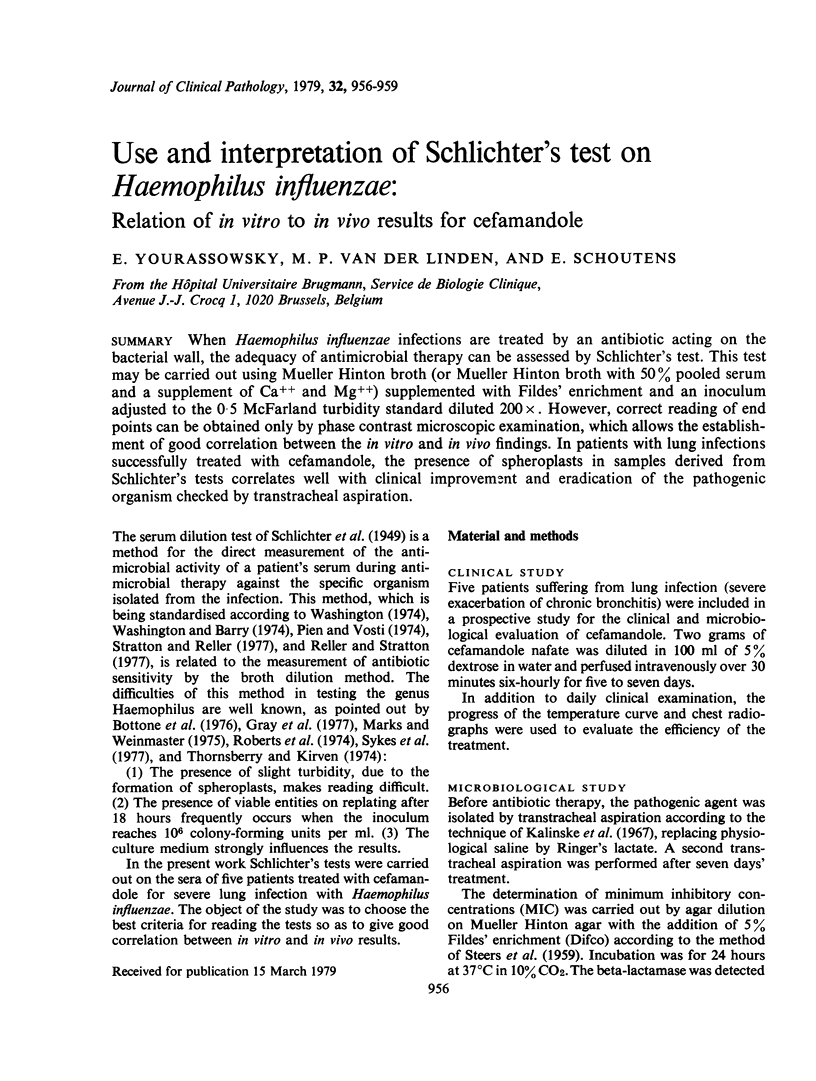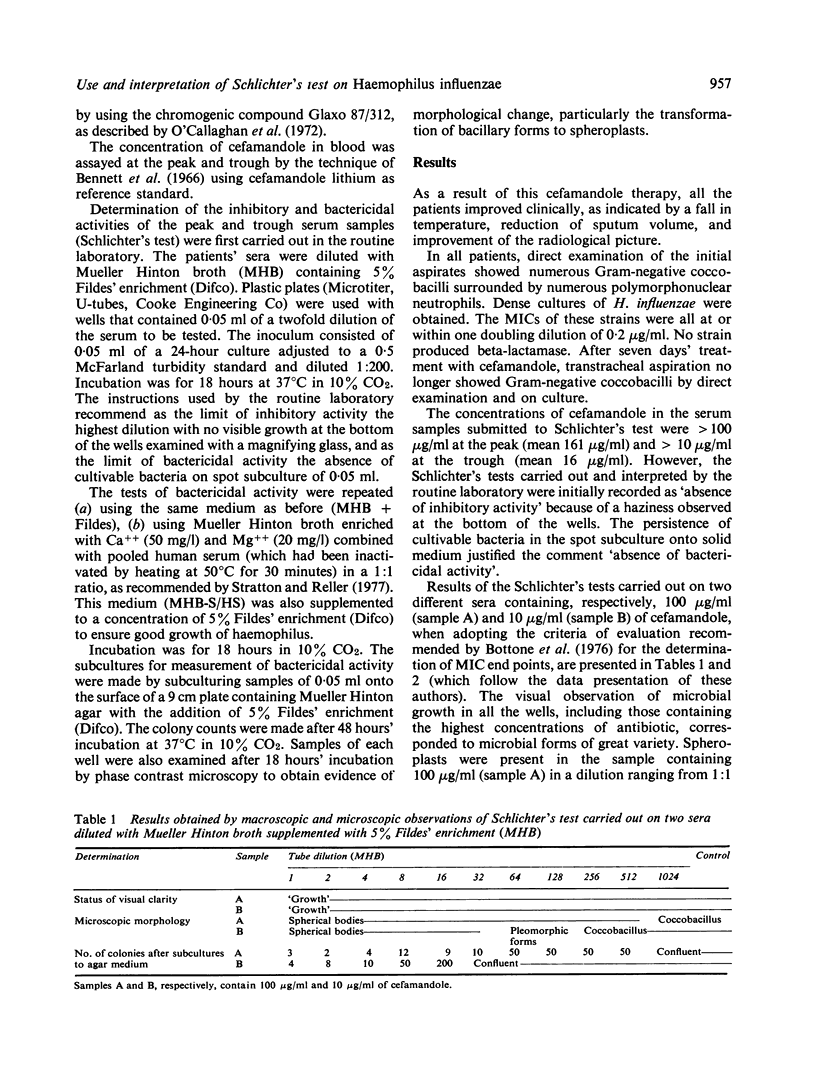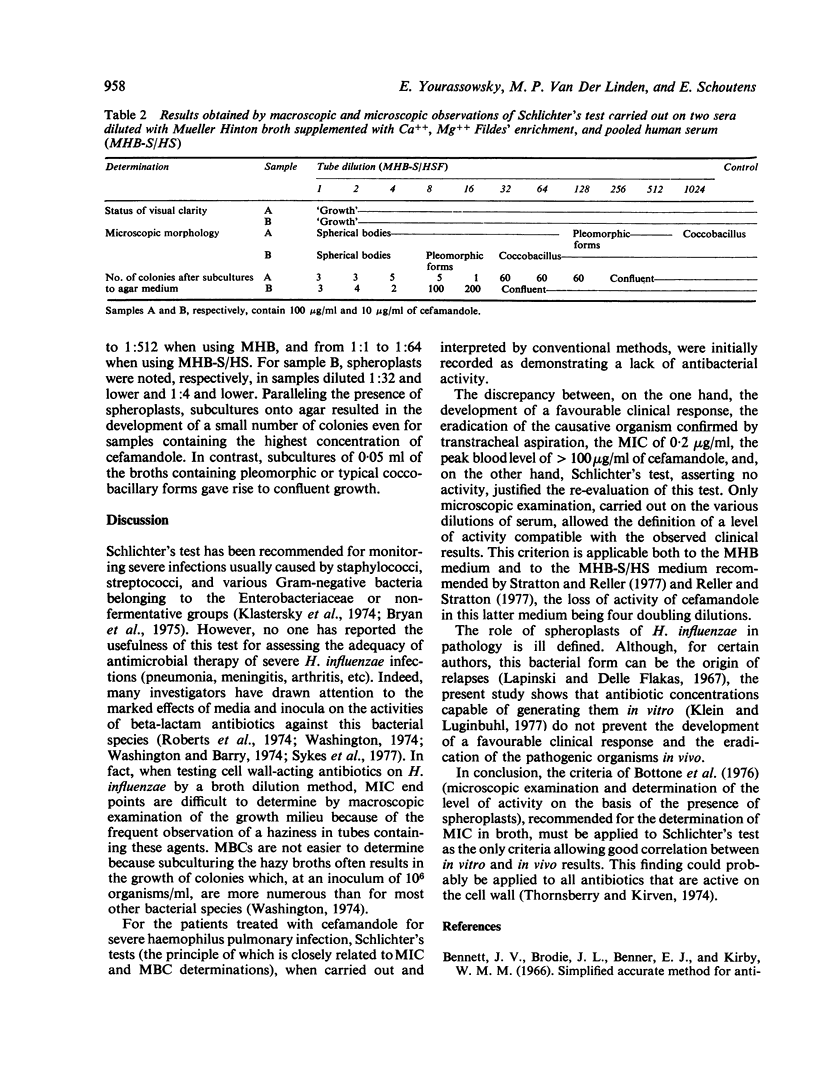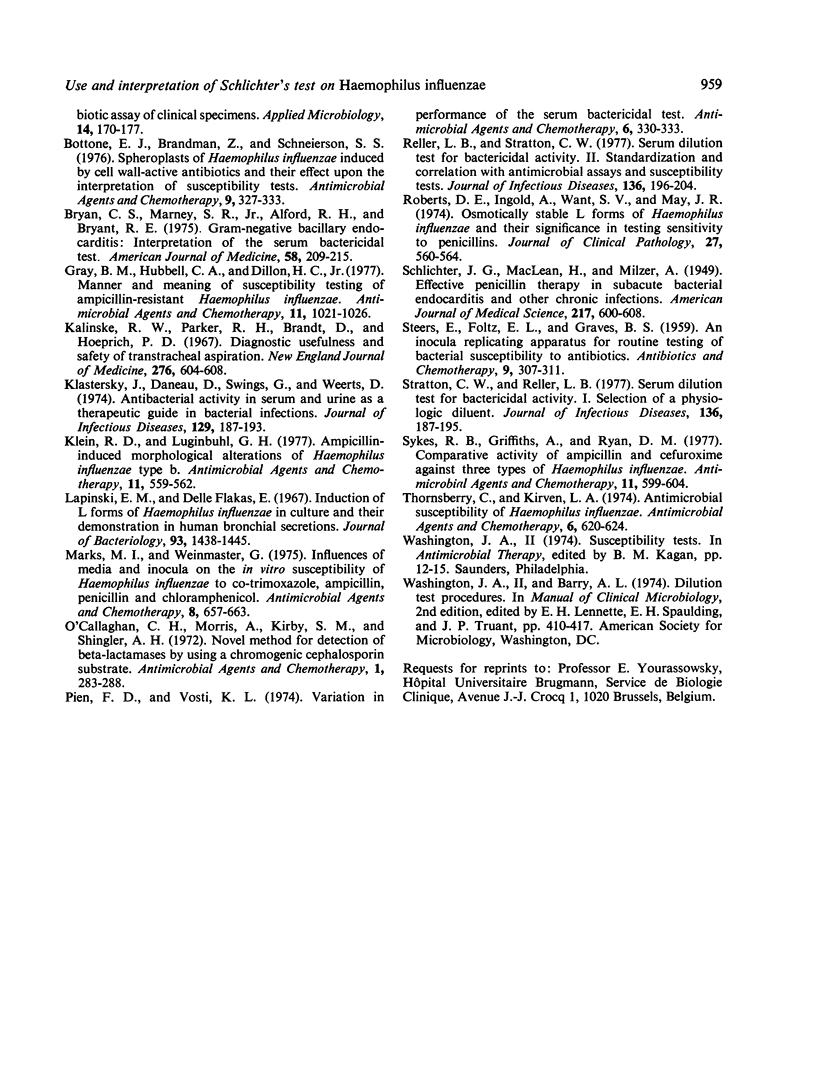Abstract
When Haemophilus influenzae infections are treated by an antibiotic acting on the bacterial wall, the adequacy of antimicrobial therapy can be assessed by Schlichter's test. This test may be carried out using Mueller Hinton broth (or Mueller Hinton broth with 50% pooled serum and a supplement of Ca++ and Mg++) supplemented with Fildes' enrichment and an inoculum adjusted to the 0.5 McFarland turbidity standard diluted 200x. However, correct reading of end points can be obtained only by phase contrast microscopic examination, which allows the establishment of good correlation between the in vitro and in vivo findings. In patients with lung infections successfully treated with cefamandole, the presence of spheroplasts in samples derived from Schlichter's tests correlates well with clinical improvement and eradication of the pathogenic organism checked by transtracheal aspiration.
Full text
PDF



Selected References
These references are in PubMed. This may not be the complete list of references from this article.
- Bennett J. V., Brodie J. L., Benner E. J., Kirby W. M. Simplified, accurate method for antibiotic assay of clinical specimens. Appl Microbiol. 1966 Mar;14(2):170–177. doi: 10.1128/am.14.2.170-177.1966. [DOI] [PMC free article] [PubMed] [Google Scholar]
- Bottone E. J., Brandman Z., Schneierson S. S. Spheroplasts of Haemophilus influenzae induced by cell wall-active antibiotics and their effect upon the interpretation of susceptibility tests. Antimicrob Agents Chemother. 1976 Feb;9(2):327–333. doi: 10.1128/aac.9.2.327. [DOI] [PMC free article] [PubMed] [Google Scholar]
- Bryan C. S., Marney S. R., Jr, Alford R. H., Bryant R. E. Gram-negative bacillary endocarditis. Interpretation of the serum bactericial test. Am J Med. 1975 Feb;58(2):209–215. doi: 10.1016/0002-9343(75)90571-9. [DOI] [PubMed] [Google Scholar]
- Gray B. M., Hubbell C. A., Dillon H. C., Jr Manner and meaning of susceptibility testing of ampicillin-resistant Haemophilus influenzae. Antimicrob Agents Chemother. 1977 Jun;11(6):1021–1026. doi: 10.1128/aac.11.6.1021. [DOI] [PMC free article] [PubMed] [Google Scholar]
- Kalinske R. W., Parker R. H., Brandt D., Hoeprich P. D. Diagnostic usefulness and safety of transtracheal aspiration. N Engl J Med. 1967 Mar 16;276(11):604–608. doi: 10.1056/NEJM196703162761103. [DOI] [PubMed] [Google Scholar]
- Klastersky J., Daneau D., Swings G., Weerts D. Antibacterial activity in serum and urine as a therapeutic guide in bacterial infections. J Infect Dis. 1974 Feb;129(2):187–193. doi: 10.1093/infdis/129.2.187. [DOI] [PubMed] [Google Scholar]
- Klein R. D., Luginbuhl G. H. Ampicillin-induced morphological alterations of Haemophilus influenzae type b. Antimicrob Agents Chemother. 1977 Mar;11(3):559–562. doi: 10.1128/aac.11.3.559. [DOI] [PMC free article] [PubMed] [Google Scholar]
- Lapinski E. M., Flakas E. D. Induction of L forms of Haemophilus influenzae in culture and their demonstration in human bronchial secretions. J Bacteriol. 1967 Apr;93(4):1438–1445. doi: 10.1128/jb.93.4.1438-1445.1967. [DOI] [PMC free article] [PubMed] [Google Scholar]
- Marks M. I., Weinmaster G. Influences of media and inocula on the in vitro susceptibility of Haemophilus influenzae to co-trimoxazole, ampicillin, penicillin, and chloramphenicol. Antimicrob Agents Chemother. 1975 Dec;8(6):657–663. doi: 10.1128/aac.8.6.657. [DOI] [PMC free article] [PubMed] [Google Scholar]
- May J. R., Roberts D. E., Ingold A., Want S. V. Osmotically stable L forms of Haemophilus influenzae and their significance in testing sensitivity to penicillins. J Clin Pathol. 1974 Jul;27(7):560–564. doi: 10.1136/jcp.27.7.560. [DOI] [PMC free article] [PubMed] [Google Scholar]
- O'Callaghan C. H., Morris A., Kirby S. M., Shingler A. H. Novel method for detection of beta-lactamases by using a chromogenic cephalosporin substrate. Antimicrob Agents Chemother. 1972 Apr;1(4):283–288. doi: 10.1128/aac.1.4.283. [DOI] [PMC free article] [PubMed] [Google Scholar]
- Pien F. D., Vosti K. L. Variation in performance of the serum bactericidal test. Antimicrob Agents Chemother. 1974 Sep;6(3):330–333. doi: 10.1128/aac.6.3.330. [DOI] [PMC free article] [PubMed] [Google Scholar]
- Reller L. B., Stratton C. W. Serum dilution test for bactericidal activity. II. Standardization and correlation with antimicrobial assays and susceptibility tests. J Infect Dis. 1977 Aug;136(2):196–204. doi: 10.1093/infdis/136.2.196. [DOI] [PubMed] [Google Scholar]
- Stratton C. W., Reller L. B. Serum dilution test for bactericidal activity. I. Selection of a physiologic diluent. J Infect Dis. 1977 Aug;136(2):187–195. doi: 10.1093/infdis/136.2.187. [DOI] [PubMed] [Google Scholar]
- Sykes R. B., Griffiths A., Ryan D. M. Comparative acitivity of ampicillin and cefuroxime against three types of Haemophilus influenzae. Antimicrob Agents Chemother. 1977 Apr;11(4):599–604. doi: 10.1128/aac.11.4.599. [DOI] [PMC free article] [PubMed] [Google Scholar]
- Thornsberry C., Kirven L. A. Antimicrobial susceptibility of Haemophilus influenzae. Antimicrob Agents Chemother. 1974 Nov;6(5):620–624. doi: 10.1128/aac.6.5.620. [DOI] [PMC free article] [PubMed] [Google Scholar]


